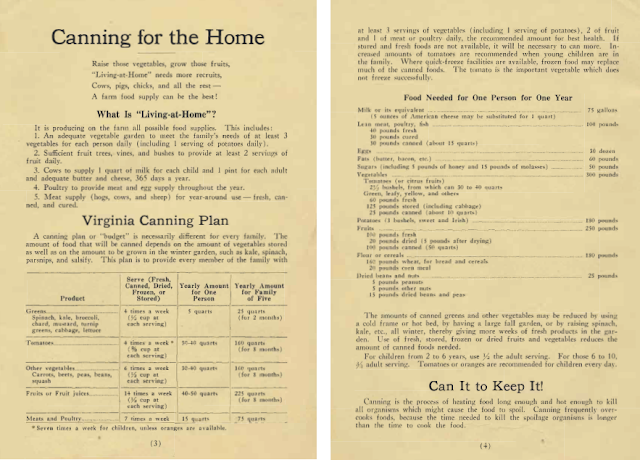Canning for the Home - Food Needed for One Year
In the 1944 publication 'Canning for the Home', produced by the Virginia Polytechnic Institute Agricultural Extension Service, it was suggested that the following is required food for one person for one year:
Using the food storage calculator at https://providentliving.com/preparedness/food-storage/foodcalc/ we see the following recommendation for one adult for one year:
Grain (includes wheat, white rice, oats, corn, barley, pasta, etc.): 400 lbs.
Legumes (dried beans, split peas, lentils, nuts, etc.): 60 lbs.
Dairy Products (powdered milk, cheese powder, canned cheese, etc.): 30 lbs.
Sugars (white sugar, brown sugar, syrup, molasses, honey, etc.): 60 lbs.
Leavening Agents (yeast, baking powder, powdered eggs, etc.): 6 lbs.
Salt (Table salt, sea salt, soy sauce, bouillon, etc.): 6 lbs.
Fats (Vegetable oils, shortening, canned butter, etc.): 30 lbs.
Water: 28 gallons*
*NOTE: The amount of water shown is a minimal 2-week supply. It is rarely practical to store more. We suggest that you store this amount and supplement it with a good water filter and/or water purification kit.
Other food storage calculators give different recommendations, but by using several different calculators, and most importantly considering your own personal needs, you can establish a reasonable baseline for what is needed for one year.
Another food storage calculator is available at Food Assets: https://foodassets.com/info/food-calculator.html
It is important to note that you will need to be able to prepare (cook) meals using your stored foods. It is of little value to store 400 pounds of grain if you can't use it to make a meal.


.png)


Comments
Post a Comment